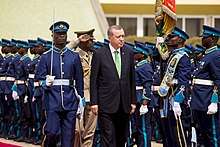Ghana Air Force
The Ghana Air Force (GHF) is the aerial warfare organizational military branch of the Ghanaian Armed Forces (GAF). The GHF, along with the Ghanaian army (GA) and Ghanaian navy (GN), make up the Ghanaian Armed Forces (GAF) which are controlled by the Ghanaian Ministry of Defence (MoD).
| Ghana Air Force | |
|---|---|
 Ghana Air Force roundel | |
| Founded | 29 July 1959 – present (60 years, 10 months) |
| Country | |
| Allegiance | Constitution of Ghana |
| Type | Air Force |
| Role | Aerial warfare |
| Size | 24 aircraft[1] |
| Part of | |
| GHF HQ | Burma Camp |
| Colors | |
| Commanders | |
| Chief of the Air Staff | Air Vice Marshal Frank Hanson |
| Insignia | |
| Fin flash |  |
| Flag |  |
| Aircraft flown | |
| Fighter | Embraer EMB 314 Super Tucano |
| Patrol | Diamond DA42 Twin Star |
| Trainer | Hongdu K-8 Karakorum |
| Transport | EADS CASA C-295 Fokker F28 Fellowship |
History
The GHF (Ghana Air Force) started on 24 July 1959 as a Flying Training School with Israeli instructors and technicians. The School was established as a cradle of a service to complement the Army and the Navy. Later that year a headquarters was established in Accra under the command of Indian Air commodore Jaswant Singh who was appointed as the first Chief of Air Staff (CAS).[2] In 1960 Royal Air Force personnel took up the task of training the newly established Ghana Air Force and in 1961 they were joined by a small group of Royal Canadian Air Force personnel. In September 1961 as part of President Kwame Nkrumah's Africanization program, a Ghanaian CAS was appointed, with the first being J.E.S. de Graft-Hayford. Although born in the U.K. he was of Ghanaian descent.
The Ghana Air Force was in the beginning equipped with a squadron of Chipmunk trainers, and squadrons of Beavers, Otters and Caribou transport aircraft. In addition a DH125 jet was bought for Kwame Nkrumah, Hughes helicopters were bought for mosquito spraying plus DH Doves and Herons. British-made Westland Whirlwind helicopters and a squadron of Italian-made MB-326 ground attack/trainer jets were also purchased.
In 1962 the national School of Gliding was set up by Hanna Reitsch, who was once Adolf Hitler's top personal pilot. Under the command of Air Commodore de Graft-Hayford, she served as director, operations instructor and trainer of the school. She also acted as the personal pilot of Kwame Nkrumah from 1962–1966.
Organisation
The GHF headquarters and main transport airfield are located in Accra, close to Kotoka International Airport. Other GHF airfields include:
GHF Air Force Station, Sekondi-Takoradi, started as RAF Station Takoradi, then it became Ghana Air Force Station, Sekondi-Takoradi, on 1 March 1961. The Chipmunk Basic Trainer Aircraft was the first aircraft used at the Station with an all Rank Air Force Station.
The GHF Air Force station, Accra, came into being soon after the Royal Air Force (RAF) had taken over the administration from the Indian and Israeli Air Force officers at the beginning of 1961. The station was housed at No 3 hangar at the Accra Airport (Kotoka International Airport) with hardly any aircraft. The Unit had four main sub-units, i.e. the Administration Wing, Flying Wing, Technical Wing and Equipment Wing. The School of Technical Training was also located at this station.
The Station moved from No 3 hangar to its present location in Burma Camp towards the end of 1965.[2]
Mission

The role of the Ghana Air Force, as defined in the National Defence Policy, is to provide “Air Transport and Offensive Air Support to the Ghana Armed Forces and to protect the territorial air space of Ghana”. The National Defense Policy further states certain specific tasks, which the Ghana Air Force is expected to perform. These tasks are as follows:
- To maintain Fighter Ground Attack capability and provide Close Air Support during operation.
- To provide transport support to the Ghana Armed Forces.
- To provide surveillance over the air space of Ghana and over the Exclusive Economic Zone (EEZ).
- To provide liaison and recce flight capability.
- To provide VIP flight capability.
- To provide transport support for civilians as government directs.
- To provide medical evacuation and air rescue assistance.
The Ghana Air Force is also responsible for the co-ordination and direction of Search and Rescue (SAR) within the Accra Flight Information Region.[2]
Aircraft
Current inventory

| Aircraft | Origin | Type | Variant | In service | Notes | |
|---|---|---|---|---|---|---|
| Combat | ||||||
| Embraer EMB 314 | Brazil | light attack / COIN | 5 on order[3] | |||
| Reconnaissance | ||||||
| Diamond DA42 | Austria | surveillance | 2[4] | |||
| Transport | ||||||
| CASA C-295 | Spain | utility / transport | 3[4] | |||
| Helicopters | ||||||
| Mil Mi-17 | Russia | utility / transport | Mi-17/171 | 6 | 2 on order[4] | |
| Bell 412 | United States | utility | 1[4] | |||
| Harbin Z-9 | China | utility | 4[4] | |||
| AgustaWestland AW109 | Italy | light utility | 2[4] | |||
| Trainer Aircraft | ||||||
| Hongdu K-8 | China | jet trainer | 4[4] | |||
| Diamond DA42 | Austria | multi engine trainer | 1[4] | |||
Retired aircraft

| Aircraft | Origin | Type | In service | Notes | ||
|---|---|---|---|---|---|---|
| Combat Aircraft | ||||||
| Aermacchi MB-339 | Italy | light attack | 4[5] | placed in storage | ||
| Transport | ||||||
| Short Skyvan | United Kingdom | transport | 2[5] | overhaul in 2004, later retired from service | ||
| BN-2T Islander | United Kingdom | transport | 4[5] | retired from service | ||
| Cessna 172 | United States | liaison / utility | 3[5] | retired from service | ||
| Helicopters | ||||||
| Bell 212 | United Kingdom | utility | 2[5] | placed in storage | ||
| Aérospatiale Alouette III | France | light utility | 5[5] | retired from service | ||
| Trainer Aircraft | ||||||
| Aero L-39ZO | Czech Republic | jet trainer | 2[5] | retired from service | ||
Chiefs of Air Staff
The senior appointment in the GHF is the Chief of Air Staff. The following is a list of the Ghana Air Force Chiefs of Air Staff:[6]
| Chief of Air Staff | Conscription | Note |
|---|---|---|
| Air Commodore K. Jaswant-Singh | May 1959 – August 1960 | Indian |
| Wing Commander I. M. Gundry-White | September 1960 – March 1961 | British |
| Air Commodore John N. H. Whitworth | March 1961 – September 1962 | British |
| Air Commodore J.E.S. de Graft-Hayford | September 1962 – July 1963 | First Ghanaian CAS |
| Air Vice-Marshal Michael Otu | July 1963 – March 1968[7] | |
| Air Commodore N. Y. R. Ashley-Larsen | March 1968 – January 1971 | |
| Air Commodore Charles Beausoliel | January 1971 – December 1971 | |
| Air Commodore N. Y. R. Ashley-Larsen | December 1971 – January 1972 | |
| Air Commodore Charles Beausoliel | December 1972 – November 1976 | |
| Air Vice Marshal George Yaw Boakye | November 1976 – June 1979 | |
| Wing Commander Samuel Gyabaah[8] | June 1979 – July 1979 | |
| Group Captain F. W. K. Klutse | July 1979 – December 1979 | |
| Air Commodore J. E. Odaate- Barnor | December 1979 – May 1980 | |
| Air Commodore K. K. Pumpuni | May 1980 – January 1982 | |
| Group Captain E. A. A. Awuviri | January 1982 – December 1982 | |
| Air Vice Marshal J. E. A. Kotei | December 1982 – June 1988 | |
| Air Marshal Harry Dumashie | June 1988 – June 1992 | |
| Air Marshal John Asamoah Bruce | 5 June 92 – February 2001 (? – 16 March 2001) |
|
| Air Vice Marshal Edward Apau Mantey | February 2001 – January 2005[9] | |
| Air Vice Marshal Julius Otchere Boateng | 20 May 2005 – to 28 January 2009[10] | |
| Air Vice Marshal M. Samson-Oje | 31 March 2009 – January 2016[11] | |
| Air Vice Marshal Maxwell Mantsebi-Tei Nagai | January 2016 – January 2019 [11] | |
| Air Vice Marshal Frank Hanson | January 2019 – Present [11] |
Rank structure
The GHF's rank structure is similar to the RAF's rank structure from where its ranks were derived.
- Commissioned officers
| Equivalent NATO code | OF-10 | OF-9 | OF-8 | OF-7 | OF-6 | OF-5 | OF-4 | OF-3 | OF-2 | OF-1 | OF(D) and student officer | |||||||||||||||||||||||||
|---|---|---|---|---|---|---|---|---|---|---|---|---|---|---|---|---|---|---|---|---|---|---|---|---|---|---|---|---|---|---|---|---|---|---|---|---|
(Edit) |
No equivalent |  |
 |
 |
 |
 |
 |
 |
 |
 |
 |
No equivalent | ||||||||||||||||||||||||
| Air Chief Marshal | Air Marshal | Air Vice-Marshal | Air Commodore | Group Captain | Wing Commander | Squadron Leader | Flight Lieutenant | Flying Officer | Pilot Officer | |||||||||||||||||||||||||||
- Enlisted
| Equivalent NATO code | OR-9 | OR-8 | OR-7 | OR-6 | OR-5 | OR-4 | OR-3 | OR-2 | OR-1 | |||||||||||||||||||||||||||
|---|---|---|---|---|---|---|---|---|---|---|---|---|---|---|---|---|---|---|---|---|---|---|---|---|---|---|---|---|---|---|---|---|---|---|---|---|
(Edit) |
 |
 |
 |
 |
No equivalent | No equivalent | No insignia | |||||||||||||||||||||||||||||
| Warrant Officer Class I | Warrant Officer Class II | Flight Sergeant | Sergeant | Corporal | Leading Aircraftsman | Aircraftsman | ||||||||||||||||||||||||||||||
References
- "World Air Forces 2014". Flightglobal Insight. 2014. Missing or empty
|url=(help) - Ghana air force. gaf.mil.gh.
- "Embraer Defense & Security sells five A-29 Super Tucano to the Ghana Air Force". prnewswire.com. Retrieved 26 April 2017.
- "World Air Forces 2020". Flightglobal Insight. 2020. Retrieved 10 March 2020.
- "World Air Forces 2004 pg, 59". Flightglobal I. 2004. Retrieved 4 December 2014.
- "Past Chiefs of Air Staff". Official website. Ghana Armed Forces. 6 February 2008. Archived from the original on 21 July 2011. Retrieved 2 November 2008.
- Military Air Vice-Marshal Archived 28 September 2007 at the Wayback Machine. thestatesmanonline.com.
- "Ghana News, Volumes 8". Ghana News. Washington, D.C. : Embassy of Ghana: 3. 1979.
- "Immediate Past Chief of Air Staff – Ghana Air Force". Official website. Ghana Armed Forces. 22 April 2005. Archived from the original on 7 January 2008. Retrieved 11 June 2007.
- "Chief of Air Staff – Ghana Air Force". Official website. Ghana Armed Forces. 21 May 2005. Archived from the original on 27 August 2007. Retrieved 11 June 2007.
- Mahama, makes changes at the military hierarchy. "Mahama makes changes at the military hierarchy". myjoyonline.com. Multimedia Group. Archived from the original on 1 August 2017. Retrieved 5 June 2017.
- World Aircraft Information Files. Brightstar Publishing, London. File 338 Sheet 03
- Veep Commissions CASA -C295 Aircraft Into Armed Forces Service. Ghanaian Times. newtimes.com.gh.
- Defence Equipment & Technology. janes.com.
External links

